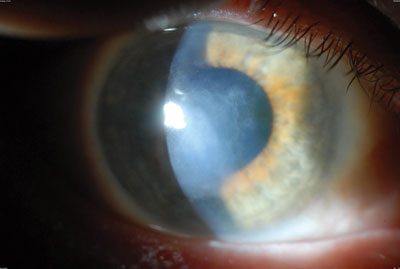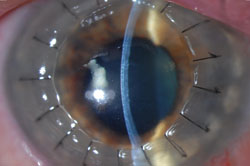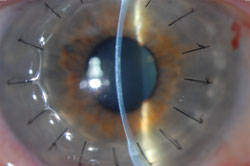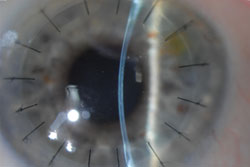Hemi-automated lamellar keratoplasty may be option for moderately deep corneal scars
Not all corneal scars are the same, and hence, not all surgical lamellar procedures are the same. The bottom line is that the corneal endothelium must be functioning normally to do any anterior lamellar procedures that would result in improved corneal clarity and improved visual rehabilitation for the patient. Additionally, if the scar is full thickness and it involves the central cornea including the visual axis, then lamellar keratoplasty is not a surgical option and by default penetrating keratoplasty becomes the procedure of choice.

Thomas John
Lamellar procedures may be divided into superficial anterior lamellar keratoplasty (SALK), mid-anterior lamellar keratoplasty (MALK), deep anterior lamellar keratoplasty (DALK) or total anterior lamellar keratoplasty (TALK) (John-Malbran classification). In general, the deeper the donor-recipient interface, the better the quality of vision. Except for SALK, which can be sutureless, the other deeper lamellar procedures require sutures to hold the donor graft in place, causing corneal astigmatism. Donor and recipient corneal parameters are usually mismatched, and surgeons need to attempt to minimize this mismatch as much as possible. One way to minimize corneal thickness mismatch is to perform a two-stage lamellar keratoplasty. In dealing with a central partial-thickness corneal scar, it is beneficial to perform a preoperative corneal optical coherence tomography scan and determine the depth of the corneal scar so that any excision includes the entire scar, leaving a clear, residual corneal bed.
In this column, Dr. Rapuano describes in a stepwise fashion a useful, surgeon-friendly anterior to mid-lamellar keratoplasty procedure that most corneal surgeons should consider adding to their surgical armamentarium.
Thomas John, MD
OSN Surgical Maneuvers Editor
by Christopher J. Rapuano, MD
There are several surgical procedures to treat eyes with anterior corneal scars. Excimer laser phototherapeutic keratectomy (PTK) is an excellent technique for fairly superficial corneal scars. Lamellar keratectomy performed freehand with a blade or with a microkeratome is another good technique for superficial scars. However, when the scar reaches more than 15% to 20% corneal thickness or is associated with moderate corneal thinning, these techniques are not ideal. At that point partial-thickness lamellar keratoplasty, DALK or PK are the next best techniques. The advantages and disadvantages of DALK and PK are widely known. The main disadvantage of DALK is the difficulty in achieving complete baring of Descemet’s membrane and the moderately high conversion rate to PK in many surgeons’ hands. Additionally, the corneal curvature in terms of mean keratometry readings and cylinder is rather unpredictable.

Christopher J. Rapuano
Partial-thickness keratoplasty, approximately 50%, has the advantage of an extremely low perforation rate and maintaining a reasonably stable corneal curvature. The main disadvantage is a lamellar interface, which can adversely affect vision. When both the recipient and donor corneas were dissected freehand with a blade, the interface haze often limited vision. This issue was addressed with automated lamellar therapeutic keratoplasty (ALTK), in which a microkeratome was used to dissect both the recipient and donor corneas. Unfortunately, achieving the exact same size and depth for donor and recipient corneas was quite challenging, and these eyes often ended up with poor vision due to significant irregular astigmatism.
The term “hemi-automated lamellar keratoplasty” (HALK) was coined by Tan’s group in 2011. HALK is a technique in which the recipient cornea is prepared freehand with a blade after partial-thickness trephination, and the donor cornea is prepared with a microkeratome and then trephined. The advantage to removing the recipient scarred anterior cornea freehand with a blade is that a rather smooth stromal lamellar dissection can be performed following the anatomic plane even when the anterior corneal surface is quite irregular. The disadvantage to using a microkeratome or femtosecond laser to remove the recipient’s scarred anterior cornea is that they cut without regard to the anatomic plan. They both applanate the anterior cornea prior to cutting it, so thin areas will yield thin areas of residual posterior cornea, causing postoperative irregular astigmatism.
The best candidates for HALK are eyes with scarring up to approximately 50% of corneal thickness with normal endothelial function (Figures 1a to 2c).

Figure 1a. Recurrent Salzmann’s-type degeneration in the right eye. This 54-year-old man had previously undergone excimer laser PTK with MMC for Salzmann’s nodular degeneration 6 years prior. It recurred, and he underwent a repeat PTK with MMC 2 years prior. It recurred again, involving the anterior 25% to 30% of the cornea.
Source: Rapuano CJ

Figure 1b. One day after HALK. The slit beam view demonstrates the lamellar interface at the intended 50% depth of the cornea.

Figure 1c. At 8 days after HALK, the graft is clearing nicely and the interface is less visible. At 10 months postop, the patient corrected to 20/30 with a spherical equivalent similar to his fellow eye.

Figure 2a. Herpes simplex virus scarring in the right eye. This 74-year-old woman had severe central corneal scarring from HSV keratitis, reaching approximately 40% to 50% corneal depth at its maximal involvement at the inferior aspect of the scar.

Figure 2b. One day after HALK. The slit beam view demonstrates the interface to be approximately two-thirds corneal depth, likely due to edema of the anterior lamellar graft.

Figure 2c. At 5 weeks after HALK, the graft is crystal clear. The interface is barely visible and appears to be at about 50% corneal depth, as intended.
Step-by-step technique
Step 1: Topical or local anesthesia can be used.
Step 2: The area of corneal pathology is measured and a trephine size is selected, generally 7 mm to 8 mm. A partial-thickness trephination, approximately 50%, is performed on the recipient, centered over the visual axis.
Step 3: If the trephination is not felt to be deep enough, a sharp rounded blade (eg, a 67 blade) can be used to begin the lamellar dissection slightly deeper than the trephination.
Step 4: An approximately 50% lamellar dissection is performed with a semi-sharp lamellar dissector (eg, Martinez spatula), extending just past the trephination.
Step 5: If significant scarring remains, the lamellar dissection can be repeated at a slightly deeper plane.
Step 6: Depending on the depth of the recipient lamellar dissection, the appropriate head size is selected for the mechanical microkeratome. It is generally 200 µm to 300 µm. The anterior donor corneal graft is prepared with the microkeratome. The anterior graft is then trephined with the same size trephine as was used for the recipient. Precut tissue can be used, but then the cap thickness needs to be determined preoperatively.
Step 7: The interface is irrigated free of debris, and the donor cornea is sutured using the surgeon’s preferred technique. Care should be taken not to perforate Descemet’s membrane during the suturing.
After surgery
Postoperative care is similar to DALK. Topical steroids and antibiotics are prescribed. The steroids are tapered over months. The sutures can be removed earlier than after DALK or PK and as needed for astigmatism management.
The main disadvantage is that it is difficult to create a lamellar graft of the exact desired thickness. It may be thinner or thicker than the tissue removed, which can affect the postoperative curvature.
The postoperative results are remarkably good. There is typically minimal interface haze. The spherical equivalent is often similar to the preoperative numbers. Astigmatism is managed similarly as with standard grafts.
In eyes with deeper scars than can be treated successfully with PTK but not deep enough to require a DALK, HALK is an emerging surgical technique. It combines the safety of not nearing Descemet’s membrane, the consistent-thickness stromal bed of a freehand recipient lamellar dissection and the smoothness of a microkeratome donor dissection in one procedure.
References:
- John T, Malbran ES. Classification of lamellar corneal surgery. In: John T, ed. Surgical Techniques in Anterior and Posterior Lamellar Corneal Surgery. New Delhi, India: Jaypee Brothers Medical Publishers; 2006:36-43.
- Rama P, Knutsson KA, Razzoli G, Matuska S, Viganò M, Paganoni G. Deep anterior lamellar keratoplasty using an original manual technique [published online ahead of print March 18, 2012]. Br J Ophthalmol. doi:10.1136/bjophthalmol-2011-301168.
- Yuen LH, Mehta JS, Shilbayeh R, Lim L, Tan DT. Hemi-automated lamellar keratoplasty (HALK). Br J Ophthalmol. 2011;95(11):1513-1518.
For more information:
- Christopher J. Rapuano, MD, is chief of the Cornea Service at Wills Eye Institute and a professor of ophthalmology at Jefferson Medical College of Thomas Jefferson University. He can be reached at Corneal Associates, 840 Walnut St., Suite 920, Philadelphia, PA 19107-5109; 215-928-3180; fax: 215-928-3854; email: cjrapuano@willseye.org.
- Edited by Thomas John, MD, clinical associate professor at Loyola University at Chicago and in private practice in Oak Brook, Tinley Park and Oak Lawn, Ill. He can be reached at 708-429-2223; fax: 708-429-2226; email: tjcornea@gmail.com.
- Disclosures: Dr. John and Dr. Rapuano have no relevant financial disclosures.
References:
- John T, Malbran ES. Classification of lamellar corneal surgery. In: John T, ed. Surgical Techniques in Anterior and Posterior Lamellar Corneal Surgery. New Delhi, India: Jaypee Brothers Medical Publishers; 2006:36-43.
- Rama P, Knutsson KA, Razzoli G, Matuska S, Viganò M, Paganoni G. Deep anterior lamellar keratoplasty using an original manual technique [published online ahead of print March 18, 2012]. Br J Ophthalmol. doi:10.1136/bjophthalmol-2011-301168.
- Yuen LH, Mehta JS, Shilbayeh R, Lim L, Tan DT. Hemi-automated lamellar keratoplasty (HALK). Br J Ophthalmol. 2011;95(11):1513-1518.
For more information:
- Christopher J. Rapuano, MD, is chief of the Cornea Service at Wills Eye Institute and a professor of ophthalmology at Jefferson Medical College of Thomas Jefferson University. He can be reached at Corneal Associates, 840 Walnut St., Suite 920, Philadelphia, PA 19107-5109; 215-928-3180; fax: 215-928-3854; email: cjrapuano@willseye.org.
- Edited by Thomas John, MD, clinical associate professor at Loyola University at Chicago and in private practice in Oak Brook, Tinley Park and Oak Lawn, Ill. He can be reached at 708-429-2223; fax: 708-429-2226; email: tjcornea@gmail.com.
- Disclosures: Dr. John and Dr. Rapuano have no relevant financial disclosures.
